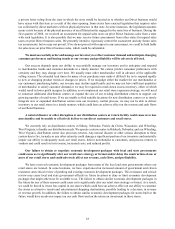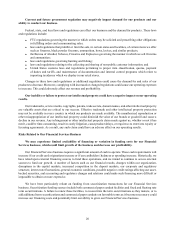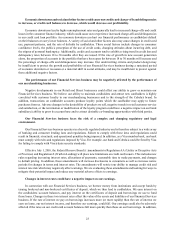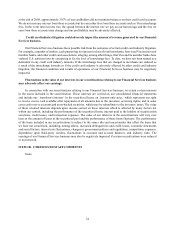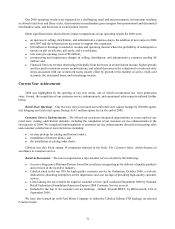Cabela's 2008 Annual Report Download - page 27
Download and view the complete annual report
Please find page 27 of the 2008 Cabela's annual report below. You can navigate through the pages in the report by either clicking on the pages listed below, or by using the keyword search tool below to find specific information within the annual report.22
With the current disruptions and weakness in the credit markets, our Financial Services business, like many
other financial institutions, has increased its funding from certificates of deposits. Our current funding strategy
includes a continued reliance on certificates of deposit to fund growth and maturing securitizations. With the
increase in other financial institutions relying on the deposits market for liquidity and funding, competition in the
deposits market may increase resulting in less funds available or funds at unattractive rates. In addition to the non-
brokered certificates of deposit market to fund growth and maturing securitizations, we have access to the brokered
certificates of deposit market through multiple financial institutions for liquidity and funding purposes. Our ability
to issue certificates of deposit is reliant on our current regulatory capital levels. If our bank subsidiary were to be
classified as an “adequately capitalized” bank, we would be required to obtain a waiver from the FDIC in order to
continue to issue certificates of deposits.
Proposed amendments to accounting standards could require us to consolidate previous and future
securitization transactions, which could materially adversely affect our financial condition and cause us to
reallocate capital from our Retail and Direct businesses to meet the capital needs of our Financial Services
business.
On September 15, 2008, the Financial Accounting Standards Board (“FASB”) issued two exposure drafts
proposing amendments to Financial Accounting Standards (“FAS”) 140, Accounting for Transfers and Servicing of
Financial Assets and Extinguishments of Liabilities and FASB Interpretation No. 46R, Consolidation of Variable
Interest Entities. Currently, the transfers of our bank subsidiary’s credit card receivables in securitization transactions
qualify for sale accounting treatment. The trusts used in our bank subsidiary’s securitizations are not consolidated
with us for financial reporting purposes because the trusts are qualifying special purpose entities (“QSPE”). Because
the transfers qualify as sales and the trusts are not subject to consolidation, the assets and liabilities of the trusts
are not reported on our consolidated balance sheet under generally accepted accounting principles. The proposed
amendments would eliminate the concept of a QSPE, modify the consolidation model for variable interest entities,
and require continual reassessment of consolidation conclusions. As proposed, these amendments would be effective
for us at the beginning of our 2010 fiscal year. The proposed amendments, if adopted, could require us to consolidate
the assets and liabilities of our bank subsidiary’s securitization trusts. This could cause us to breach certain financial
covenants in our credit agreements and unsecured notes. This could have a significant effect on our financial condition
and ability to meet the capital maintenance requirements of our bank subsidiary, as affected off-balance sheet loans
would be recorded on our consolidated balance sheet and may be subject to regulatory capital requirements.
It may be difficult to sustain the historical growth and profitability of our Financial Services business,
and we will be subject to various risks as we attempt to grow the business.
We may not be able to retain existing cardholders, grow account balances, or attract new cardholders and the
profits from our Financial Services business could decline, for a variety of reasons, many of which are beyond our
control, including:
• credit risk related to the loans we make to cardholders and the charge-off levels of our credit card
accounts;
• inability of cardholders to make payments to us due to current economic conditions and limited access to
other credit sources;
• inability to manage credit risk and keep credit models up to date with current consumer credit trends;
• lack of growth of potential new customers generated by our Retail and Direct businesses;
• liquidity and funding risk relating to our ability to create the liquidity necessary to extend credit to our
cardholders and provide the capital necessary to meet the requirements of government regulators and
Visa; and
• operational risk related to our ability to acquire the necessary operational and organizational infrastructure,
manage expenses as we expand, and recruit management and operations personnel with the experience to
run an increasingly complex and highly-regulated business.








